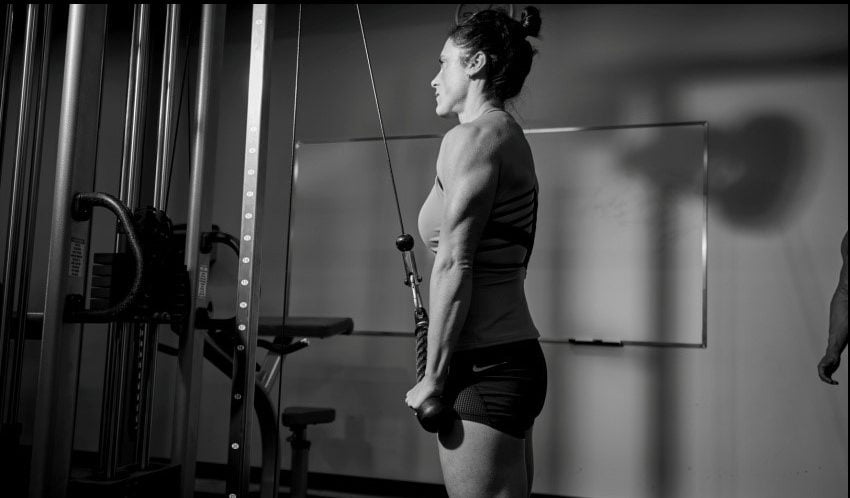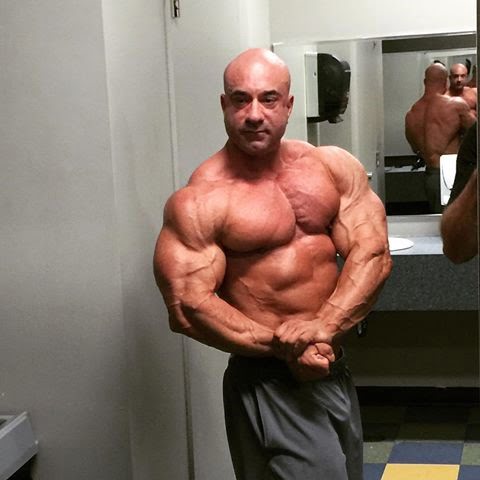Knowledge
Maximum Muscle Method: Mechanical Drop Sets
Articles, Muscle gain, Training

Maximum Muscle Method: Mechanical Drop Sets
If you are hitting the gym seriously, chances are that your main goal is one of these:
- Building more muscle
- Getting stronger
- Getting leaner
And if you read my articles, the first two likely hold a special place in your heart. In the past, I’ve written about three of my favourite methods for size and strength: clusters, rest/pause and drop sets
I’ve also written about great loading schemes like the 1-6 contrast and wave loading. These are awesome if your goal is to gain maximum strength.
If your main goal is pure muscle growth, one of the methods I highly recommend is mechanical drop sets. At the moment, I’m working with IFBB pro Robin Strand and mechanical drop sets are a huge part of his programming.

In the past, I’ve also used mechanical drop sets extensively with IFBB pro Patrick Bernard.

To me, this method is to hypertrophy what clusters are for strength: the best method for rapid results.
40-70 seconds To Grow
There are several ways to stimulate muscle growth. Here are the four main ones:
- Muscle fibre fatigue. To quote Professor Zatsiorsky: “A muscle fibre that was recruited but not fatigued was not trained”. This approach is supported by the work of Cameron and Mitchell (2012) that showed that if you train to muscle failure (until you can’t lift a weight anymore) the muscle gains re the same over an 8-week period whether you used 30% or 80% of your maximum.
- Muscle damage: Muscle damage has long been known to be a trigger for muscle growth. In fact, for decades it was even seen as the only way to stimulate growth. Damaging the muscle cells triggers the repair process, which is driven by the immune system and relies heavily on stem cells (they donate their material to repair the damaged muscle fibres and build them thicker).
- MTOR activation: MTOR triggers protein synthesis and initiates the muscle-building process. While every type of resistance training stimulates mTOR activation, two types have a greater impact: loading the eccentric portion of the movement and having a muscle under significant tension while it is stretched.
- Local growth factors and lactate release: Accumulating lactate (lactic acid), the burn, has long been associated with muscle growth by bodybuilders. And science has recently shown that they were right! Lactate itself can trigger muscle growth (Oishi et al. 2015, Nalbandian and Takeda 2016). Lactate increases stem cell activity, increases follistatin and decreases myostatin which leads to muscle growth. A correlation between lactate and MGF (IGF-1) release in muscle has also been found. These local growth factors will directly stimulate protein synthesis in the muscle.
Among these methods, no. 1 (muscle fatigue) and 4 (growth factors/lactate accumulation) have something in common: they require that a set lasts for a fairly long time. This is required to create a significant amount of muscle fatigue but also to trigger a maximum release of lactate.
Anecdotally, and scientifically 40-60 seconds is the optimal time under tension for a set to maximize these two methods. This is the zone in which you have the greatest release of lactate and growth factors while also fatiguing the most muscle fibres (going lighter might not recruit the higher threshold fibres as well).
Method 2 (muscle damage) requires a higher loading. If the weight is too light, the tension during the eccentric is too low and won’t cause as much muscle damage. When it comes to muscle damage, the following applies:
- The eccentric portion of a lift seems to cause more muscle damage
- Fast-twitch fibres are more prone to muscle damage (because they do most of the work during the eccentric phase)
- A less synchronized muscle action during eccentric leads to more micro-tears
- As MU coordination improves, synchronization is better which means less damage
- As such, exercise variation is more important to cause muscle damage than for other ways of stimulating hypertrophy. When you get more efficient at a lift, you will cause less muscle damage because the fibers are better synchronized during the eccentric
- The turnaround point, where you are switching for eccentric to concentric is key. More tension when the muscle turns around means more muscle damage
- Muscle damage is a function of the amount of tension (weight) and the Time Under Tension (volume)
- Very light weight + high reps = low damage
- Very heavyweight + low reps = low damage
- The optimal zone to train in is between 70 and 82.5%
As you can see, under normal circumstances it is hard to cause maximum muscle damage with sets lasting 40-70 seconds because you won’t be able to reach that set duration when using 70-82.5%. Best case scenario you might be able to reach 40 seconds by doing 10 fairly slow reps with 70%.
Enter Mechanical Drop Sets
A good way to combine a weight in the 70-82.5% and a duration of 40-70 seconds is to use mechanical drop sets.
Mechanical drop sets consist of doing 3-4 variations of the same exercise (or something very similar) with the same weight, without any rest (or at the most 10 seconds).
It’s like a drop set, but instead of dropping the weight, you switch to an “easier” variation of the pattern. When you reach failure (or close to it) on a variation you can still do reps on the next one because it’s an easier one.
For example:
- 8 reps with 80lbs dumbells on standing shoulder press
- Rest 10 seconds
- 5 reps with 80lbs dumbells on the incline DB press
- 4 reps with 80lbs dumbbells on the flat DB press
If you use a “normal” tempo of 3010 (3 seconds down, 1 second up) that comes down to 68 seconds under load which is at the top of the optimal lactate zone.
You get the lactate, the growth factors, muscle fibre fatigue but also muscle damage…
You get the muscle damage because you will be right in the 70-82.5% zone on that first exercise (which is the key exercise). The extra two variations are only there to extend the time under tension and continue fatiguing the muscle fibres. You will bring in some new fibres (and even some new muscles), but you will continue to recruit and fatigue the fibres involved in the first movement.
The cool thing with mechanical drop sets is that on top of a greater growth stimulus, they are time-efficient because you are hitting various angles in a set.
Building A Mechanical Drop Set
Designing a mechanical drop set is simple. You select three variations of an exercise (it can even be loosely related, as long as they hit the same muscle). For example, lateral raise/front raise/Arnold press.
Then you rank them in order from the “weakest” to the “strongest”.
You do them in that order:
- Weakest
- Moderate
- Strongest
And voila!
Here are some simple examples of a mechanical drop set:
Front raise mechanical drop set: Here we are widening the grip with each position. A wider grip reduces the resistance arm (weight is closer to you), which makes the movement a bit easier:
Lat pulldown mechanical drop set: We change the position of the bar or torso. Starting with the behind the neck pulldown, then switching to in front with an upright torso and then leaning back at the end.
EZ bar curl mechanical drop set: In this example, I start by doing a leaning away curl, this gives you the worst leverage and keep the muscle under maximal tension for longer, which makes it very difficult. Then switching to regular curls and finally doing leaning forward curls which decrease the range of motion, making it much easier.
Triceps press down mechanical drop set: This is one of my favourites. You start with supinated press down, which is really weak, then you switch to the rope and you finish with the pronated variation. Note that Gen is using two pulleys to save time, but you can use a single pulley and change he handle, the 10 seconds needed to make the switch won’t be a problem.
You get the idea. Pretty easy to come up with your own variations. But here are a few suggestions:
Delts
- Lateral raise / Front raise / Arnold press
- Behind the neck press / Shoulder press / Push press
- Arnold press / DB shoulder press / DB push press
- DB shoulder press / High incline (60 deg) DB incline press / Incline (30 deg) press
Chest
- Close-grip bench press / Normal bench press / Wide bench press
- High incline (60 deg) DB press / Incline (30 deg) press / Flat DB press
- DB squeeze press / DB flies / DB press
- Smith machine reverse grip bench / Smith close-grip bench / Smith machine bench
- Pec deckhands at neck level / Pec deck hands just below shoulders / Pec deck hands bottom of pecs
Lats
- Behind the neck pulldown / Pulldown in front upright / Pulldown in the front leaning back
- Cable seated row leaning forward / Seated row 90 degrees / Seated row leaning back
- Straight-arm pulldown upright / Straight-arm pulldown leaning forward / Kneeling front pulldown
Mid-back
Pendlay row / Bent over row torso 100 degrees / Bent over row torso 135 degrees
Biceps
- Leaning away EZ bar curl / EZ bar curl / EZ bar curl leaning forward
- Reverse DB curl / DB curl / Hammer curl
- Reverse grip EZ bar curl / Wide EZ bar curl / Narrow EZ bar curl
- Incline DB curl / Incline hammer curl / Standing alternating hammer curl
Triceps
- Reverse press down / Rope press down / Pressdown
- EZ bar lying triceps extension / EZ bar pullover / EZ bar close-grip press
- Pronated lying DB triceps extensions / Neutral DB triceps extension / Tate press
- Lying bar triceps extension / JM press / Close-grip bench press
- 6″ close-grip bench / 12″ close-grip bench / regular grip bench
Quads
- Hack squat feet together / Hack squat medium stance / Hack squat feet wide
- Leg press feet low and together / Leg press medium stance in middle/
Leg press feet wide and high - Narrow step lunges / Long step lunges / DB squats
- Front squat / Narrow back squat heels elevated / Wide back squat
Hamstrings
- Lying leg curl legs turned in / Lying leg curl legs neutral / Lying leg curl legs turned out
- RDL front of feet elevated / RDL / RDL wide stance
- Single leg RDL / Bulgarian split squat / Bulgarian split squat wide
Conclusion
Mechanical drop sets are an amazing way to build muscle. I recommend using a weight that you can get for anywhere between 6 and 10 reps on the initial movement and doing 2-4 work sets depending on your capacity to recover. I normally use one such “exercise” for a muscle group in a session. If I train two muscles in a workout I can do two different mechanical drop sets (one for each muscle). Give them a shot if maximum growth is your goal you won’t be disappointed.
-CT